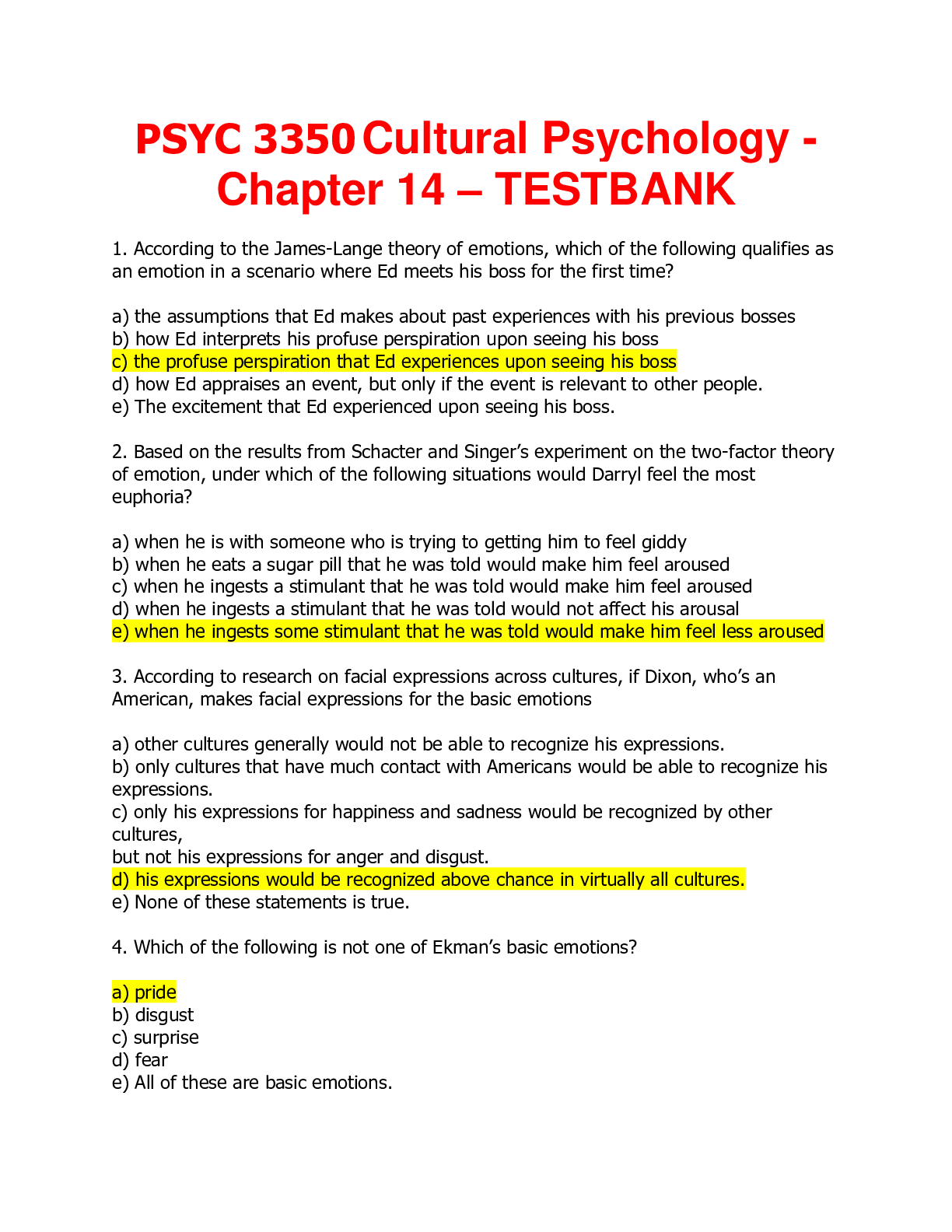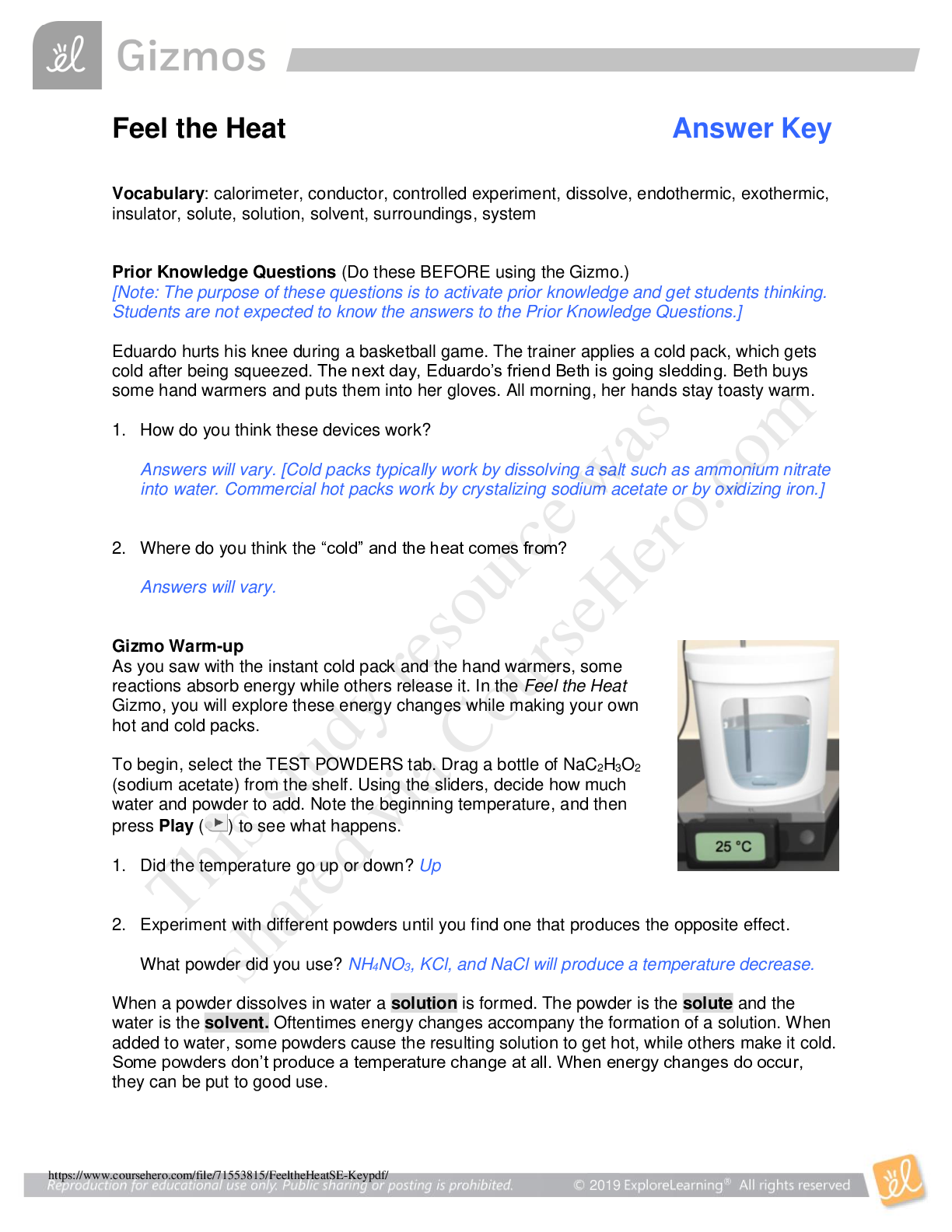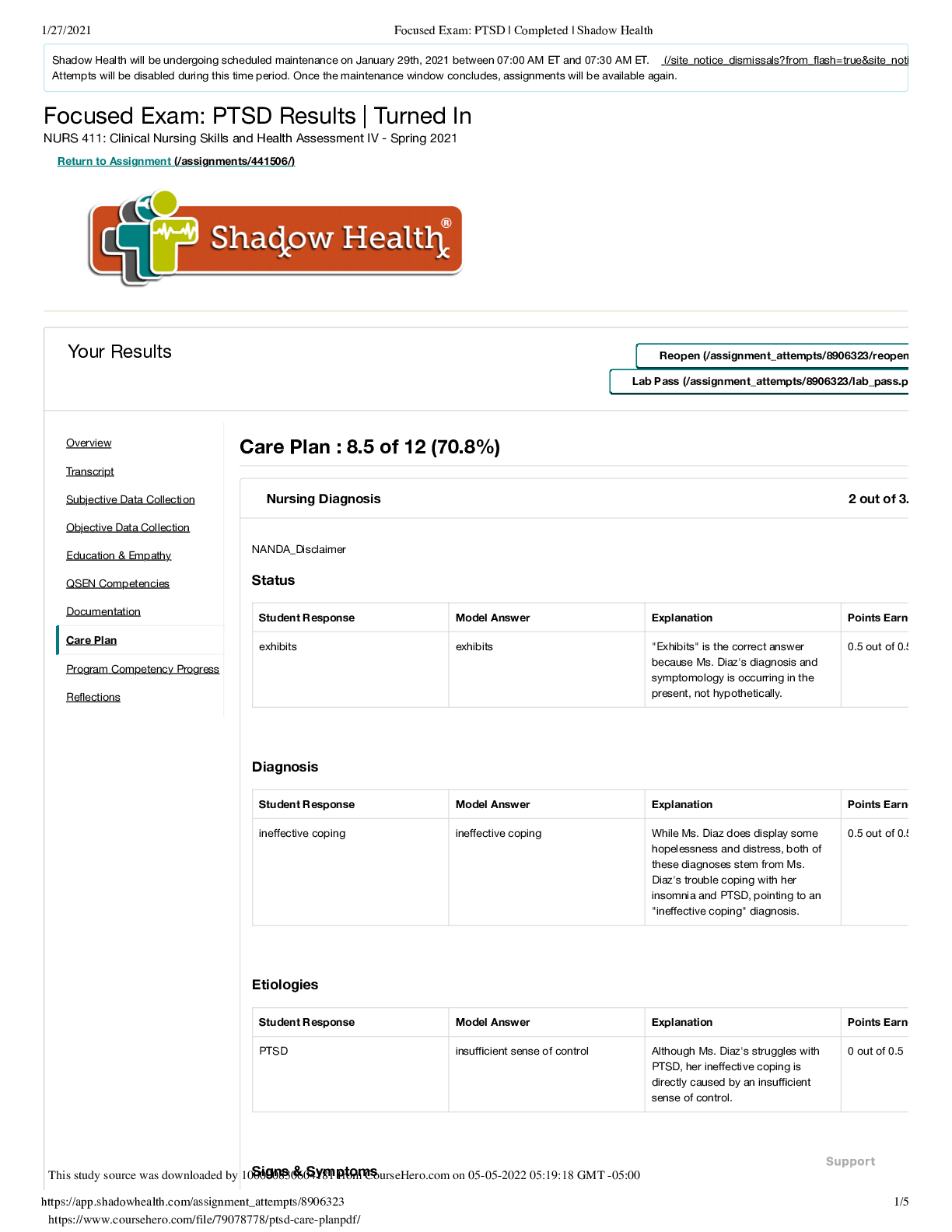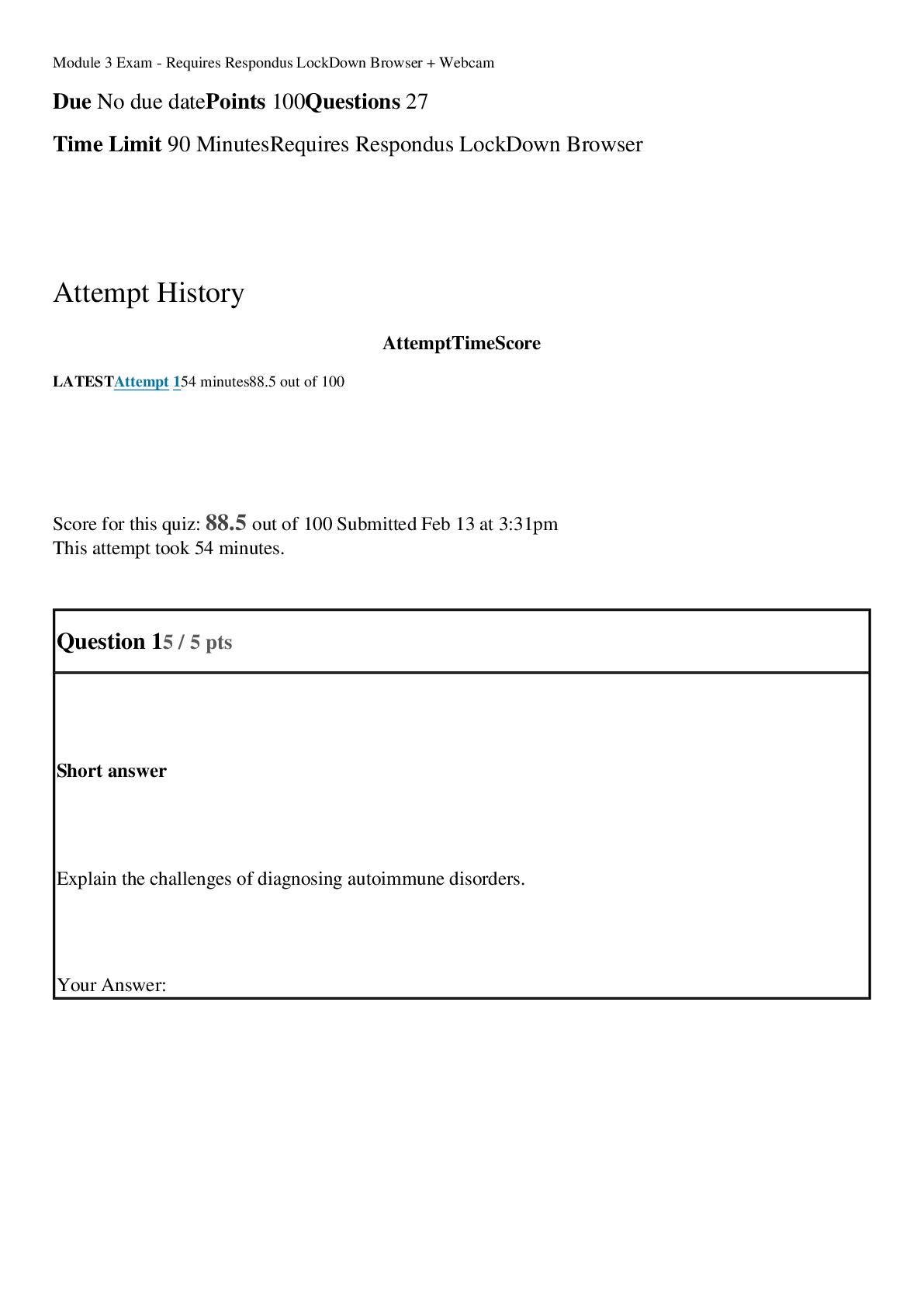CCRP AACVPR TESTBANK QUESTIONS WITH COMPLETE SOLUTIONS (GRADED A)
Document Content and Description Below
How are lipids carried on lipoproteins in the blood because they are insoluble in water Proteins found on lipoproteins apolipoproteins Density of lipoprotein with less lipid and greater pr... otein more dense Density of lipoprotein with more lipids and less protein less dense Major bloodstream lipoproteins chylomicrons, vLDL, LDL, HDL Chylomicrons least dense of the lipoproteins and are triglyceride-rich particles that are formed in the intestine Function of Chylomicrons and where they can be found Transport dietary fat and can be found in the bloodstream at highest concentration soon after a meal Least to most dense lipoprotein particles Chlyomicron, vLDL, LDL, HDL lipoprotein that is the most atherogenic of all lipoproteins LDL LDL carries 60-70% of the cholesterol in the blood HDL carries 20-30% of the cholesterol in the blood Equation for total LDL-C in bloodstream LDL= TC-(HDL-C-(TG/5)) When does calculating LDL-C become inaccurate when TG exceeds 400mg/dL Desirable total cholesterol level <200 Borderline high total cholesterol level 200-240 High total cholesterol level >240 Optimal TG level <150 Borderline high TG level 150-199 High TG level 200-499 Very high TG levels >500 Optimal in men HDL levels >40 Optimal in women HDL levels >50 Optimal LDL-C levels <100 Near optimal LDL-C levels 100-129 Borderline high LDL-C levels 130-159 High LDL-C levels 160-189 Very high LDL-C levels >190 Hypertriglycerdemia is associated with high levels of VLDL-C Non-HDL-Cholesterol calculation HDL-C - Total cholesterol Atherogenic dyslipidemia Elevated levels of TG, low HDL-C and only modest elevations of LDL-C Metabolic syndrome requires the presence of any 3 of the following conditions: abdominal obesity, elevated TG, low HDL, elevated BP and hyperglycemia Criteria for metabolic syndrome: Abdominal obesity WC >102 cm (40 in) for men WC >88cm (35 in) for women Criteria for metabolic syndrome: Hypertriglyceremia ≥150 or drug treatment Criteria for metabolic syndrome: Low HDL <40 for men <50 for women Criteria for metabolic syndrome: Elevated BP SBP ≥130 DBP ≥85 or drug treatment Criteria for metabolic syndrome: Hyperglycemia Fasting glucose ≥100 or drug treatment AACVPR understanding of atherosclerosis Traditional risk factors are a source of inflammatory changes in the blood vessel wall --> which attract lipid laden macrophages and other inflammatory cells to enter the blood vessel wall --> where they proliferate and develop atherosclerotic plaques --> which are the source of the clinical manifestations of CHD Fatty streaks lipid deposition (daily lipid laden macrophages) in the arterial wall Lumen opening inside of the blood vessel fibrous plaque Larger and more obstructive lesoions consisting of an outer fibrous Why do plaque ruptures occurs prior to the development of cardiovascular symptoms in many cases Atherosclerotic plaques that are prone to rupture tend to be younger, more immature plaques that usually do not produce the degree of luminal narrowing required to develop exertion symptoms What occurs after a plaque rupture Clot formation within the lumen of the coronary artery, potential resulting in an acute coronary syndrome from the sudden development of severe obstruction to coronary blood flow Examples of foods high in dietary cholesterol Animal products ( meat, poultry, fish, eggs, butter, cheese, whole and 2% milk) Examples of foods high in saturated fatty acids high fat meats (beef, lamb, pork, poultry with skin, beef fat, lard), dairy products, tropical oils ( palm oil, palm kernel oil, coconut oil) Examples of foods high in trans fatty acids fried foods, baked goods, stick margarines, shortenings Examples of foods high in monounsaturated fatty acids vegetable oils (olive oil, canola oil, peanut oil, sunflower oil, sesame oil) , avocados, peanutbutter, nuts and seeds Examples of foods high in polyunsaturated fatty acids vegetable oils (soybean oil, safflower oil), fatty fish ( salmon, mackerel, herring, trout) nuts (walnuts), seeds (sunflower seeds) ACC/AHA Lifestyle Management Guidelines Dietary recommendations for lowering LDL-C 1) consume a dietary pattern that emphasizes; vegetables, whole grains and fruits; low fat dairy products, fish, legumes, non-tropical oils and nuts; limit sweets, sugared beverages and red meats 2) Aim for a diet of 5-6% of calories from saturated fats 3) Reduce percent calories from saturated fats 4) Reduce percent of calories from trans fats What are unrefined carbohydrates referred as whole grains Strongest evidence for dietary patterns DASH diet (dietary approach to stop hypertension) Function of statins reduce cholesterol production in the liver by inhibiting the enzyme HMG CoA reductase When to investigate into possible secondary causes of hyperlipidemia LDL-C >190 mg/dL and triglycerides >600mg/dL LDL-C reduction on low intensity statin <30% LDL-C reduction on moderate intensity statin 30-<50% LDL-C reduction on high intensity statin >50% Secondary causes of elevated LDL diets high in saturated fat/trans fat, weight gain, anorexia, diuretics, cyclosporine, glucocorticoids, amiodarone, binary obstruction, nephrotic syndrome, hypothyroidism, obesity, pregnancy Secondary causes of elevated triglycerides Diets high in refined carbs, weight gain, very low fat diets, excessive alcohol intake, estrogens, glucocorticoids, bile acid sequestrates, protease inhibitors, retinoid acid, anabolic steroids, sirolimus, ralozifene, tamoxifen, beta blockers, thiazide diuretics, chronic renal failure, nephrotic syndrome, lipodystrophies, diabetes, hypothyroidism, obesity, pregnancy Rosuvastatin 5, 10mg intensity moderate Rosuvastatin 20, 40 mg intensity high Atorvastatin 10, 20 mg intensity moderate Atorvastatin 40, 80mg intensity high Simvastatin 10mg intensity low Simvastatin 20, 40 mg intensity moderate Pravastatin 10, 20 mg intensity low Pravastatin 40, 80mg intensity moderate Lovastatin 20mg intensity low Lovastatin 40mg intensity moderate Fluvastatin XL 80mg intensity moderate Fluvastatin 20, 40mg intensity low Fluvastatin 40 mg BID intensity moderate Pitavastatin 1mg intensity low Pitavastatin 2, 4mg intensity moderate Moderate - High intensity Statins Rosuvastatin, Atorvastatin Low-Moderate intensity Statin Simvastatin Pravastatin Lovastatin Fluvastatin Pitavastatin What is the decision based on about whether to initiate statin therapy and what dose based on an individuals global CVD risk rather than LDL level Reassessment recommendations of lipid profile repeating repeat in 4-12 weeks after initiation of statin therapy and 3-12 months periodically thereafter to access for the expected response to therapy Four clinical groups that benefit from statin therapy -Clinical ASCVD -LDL-C ≥190 -Diabetes, aged 40-75, LDL 70-189 and no clinical ASCVD -Aged 45-70, LDL 70-189, no diabetes or clinical ASCVD and 10 year risk for ASCVD ≥7.5% Intensity of statin recommended for groups with Clinical ASCVD High intensity for those ≤75 Moderate intensity for those >75 Intensity of statin recommended for groups with LDL ≥190 High intensity Intensity of statin recommended for groups with Diabetes, aged 40-75, LDL 70-189 and no clinical ASCVD Moderate intensity *If 10 year risk ≥7.5%, option use of high intensity Intensity of statin recommended for groups with Ages 45-70, LDL 70-189, no DM, or clinical ASCVD and 10 year risk for ASCVD ≥7.5% Moderate to high intensity Clinical ASCVD - acute coronary syndrome - history of MI - stable or unstable angina - coronary or other arterial revascularization - stroke/TIA - peripheral artery disease Two most common reasons the result in non-adherance to statin therapy Muscle side effects and transaminitis Lipid effects of Niacin flushing, transaminitis, hyperglycemia, hyperuricemia Lipid effects of bile acid sequestrates hypertriglycermia Lipid effects of cholesterol absorption inhibitors transaminitis Lipid effects of vibrates myopathy, renal dysfunction Lipid effects of omega 3 ftty acids DI disturbances, skin changes, bleeding Transaminitis having high levels of certain liver enzymes called transaminases. Myalgias muscle pain Rhabdomyolysis -condition in which damaged skeletal muscle breaks down rapidly (caused by trauma, extreme exertion, or drug toxicity; in severe cases renal failure can result) -death of muscle fibers and release of their contents into the bloodstream. What type of contraindication: Recent changes in ECG absolute What type of contraindication: unstable angina absolute What type of contraindication: uncontrolled cardiac arrhythmias absolute What type of contraindication: symptomatic severe aortic stenosis or other valvular disease absolute What type of contraindication: decompensated symptomatic heart failure absolute What type of contraindication: acute PE or pulmonary infarction absolute What type of contraindication: acute non cardiac disorder that may affect exercise performance or may be aggravated by exercise (infection,thyrotoxisosis) absolute What type of contraindication: acute myocarditis or pericarditis absolute What type of contraindication: acute thrombophlebitis absolute What type of contraindication: physical disability that would preclude safe and adequate exercise performance absolute What type of contraindication: electrolyte abnormalities relative What type of contraindication: tachyarrhythmias or bradyarrhythmias relative What type of contraindication: high degree atrioventricular block relative What type of contraindication: atrial fibrillation with uncontrolled rate relative What type of contraindication: hypertrophic obstructive cardiomyopathy with peak resting left ventricular outflow gradient of >25mmHg relative What type of contraindication: known aortic dissection relative What type of contraindication: severe resting arterial HTN (SBP >200 and DBP >100) relative What type of contraindication: mental impairments leading to inability to cooperate with testing relative Adverse réponse to inpatient exercise leading to exercise discontinuation -DBP ≥110 mmHg -Decreased SP >10mg -Significant ventricular or atrial dysrhythmias -second or third degree heart block -s/s of exercise intolerance including angina, dyspnea, EKG changes suggestive of ischemia P wave normal response to exercise minor and insignificant changes in morphology P and T wave of successive beats normal response to exercise superimposition Septal Q wave amplitudes normal response to exercise increases R wave amplitudes normal response to exercise slightly decreases T wave amplitude normal response to exercise increases QRS duration normal response to exercise minimal shortening J point normal response to exercise depression QT interval normal response to exercise rate related shortening ST segments may be affected by resting ECG configuration (BBB, LVH) and pharmacological agents Depression of J point that leads to marked ST segment up sloping is due to competition between normal depolarization and delayed terminal depolarization faces rather than to ischemia Exercise induced myocardial ischemia may be manifested by three different types of ST segment changes in ECG -ST segment elevation -ST segment depression -ST segment normalization or absence of change ST segment elevation represents (electric conductivity) early depolarization If ST segment is seen in normal ECG, increase HR may cause elevated ST segment to return to isoelectric baseline Exercise induced ST-segment elevation in leads displaying a previous Q wave infarction may be indicative of wall motion abnormalities or ventricular aneurysm Exercise induced ST segment elevation on a normal EKG (except aVR or V1-V2) indicates significant myocardial ischemia and localizes the ischemia to a specific area of the myocardium ST segment elevation indicates myocardial injury when followed by the evolution of significant Q-waves St segment depression criteria depression of the j point and the slope at 80 sec past the J point St segment depression is the most common manifestation of exercise-induced myocardial ischemia Horizontal or downsloping St segment depression is more indicative of myocardial ischemia than is up-sloping depression The standard criteria of a positive stress test is (St segment depression) ≥1mm of horizontal or down sloping ST segment 80msec after the J point slowly up-sloping St segment depression should be considered a borderline response St segment depression does not localize ischemia to a specific area of myocardium The more leads with apparent ischemic ST segment shifts, the more sever the disease St segment depression occurring only in recovery likely represents a true positive response and should be considered an important diagnostic finding In the presence of baseline ST abnormalities on the resting EKG, additional ST segment depression during exercise is less specific for myocardial ischemia ST segment abnormalities for those with LBBB developed during exercise are uninterpretable with respect to evidence of ischemia In RBBB exercise induced ST segment depression in the anterior precordial leads (V1, V2 and V3) are not used at diagnose ischemia In RBBB exercise induced ST segment depression in the lateral leads (V4, V5 and V6) may be indicative of ischemia even in the pretense of RBBB ST/HR index ratio of the maximal ST-segment change to the maximal change in HR from rest to peak exercise ST/HR index of ≥1.6 abnormal ST/HR slope evaluates the maximal slope relating the amount of ST segment depression to HR during exercise ST/HR slope of >2.4mV/beat/min abnormal ECG abnormalities at rest (T wave inversions/ST segment depression) may return to normal during anginal symptoms and during exercise for some patients Major mechanism of dysrhythmias increased sympathetic drive and changes in extracellular and intercellular electrolytes, PH and oxygen tension contribute to disturbances in myocardial and conducting tissue automaticity and reentry Atrial flutter or atrial fibrillation may occur in organic heart disease or may reflect endocrine, metabolic, or drug effects Criteria of frequent ectopy >7 beats per minute Criteria for terminating exercise based on ventricular ectopy includes sustained ventricular tachycardia, multifocal PVCs, and triplets of PVCs also influenced by simultaneous evidence of ischemia and/or s/s Muscular strength ability of a muscle to exert a maximal force through a given range of motion or at a single given point Muscular endurance the capacity of a muscle to exert a sub maximal force through a given range of motion or at a single point over a given time cardiovascular endurance ability to continue training the cardiovascular system for a period longer than twenty minutes flexibility ability of a joint to move through a full range of motion body composition the ratio of lean body mass to fat body mass CAD patients are more likely to have a maximal MET capacity of 5-10 METs Oxygen uptake the amount of oxygen consumed by the body's tissues oxygen uptake through Fick equation VO2=cardiac output x artery-venous oxygen content difference What can limit VO2 peak central and/or peripheral impairments peak oxygen uptake levels of very low functional capacity [Show More]
Last updated: 8 months ago
Preview 1 out of 143 pages
Instant download
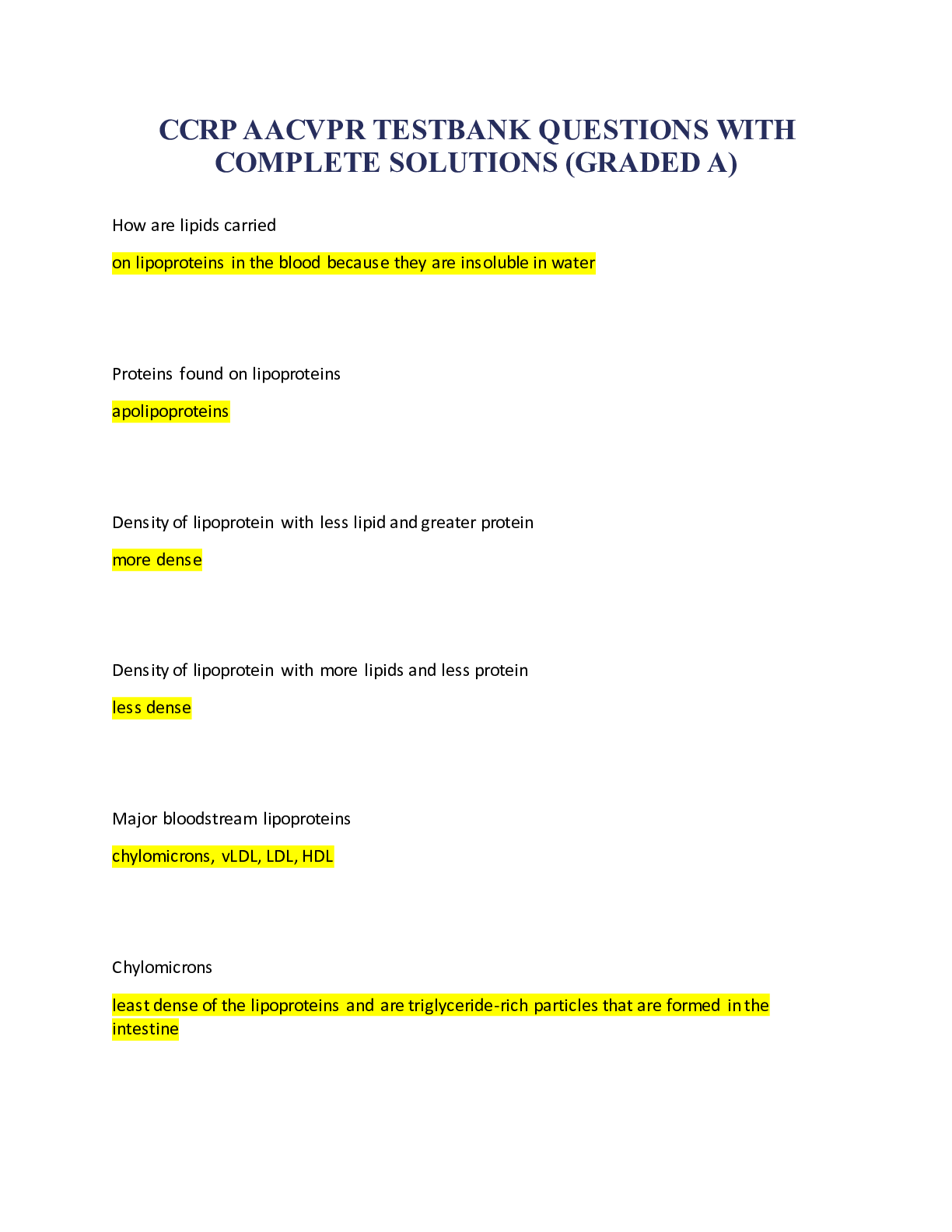
Buy this document to get the full access instantly
Instant Download Access after purchase
Add to cartInstant download
Also available in bundle (1)

CCRP AACVPR TESTS COMPILATION PACKAGE DEAL (100% Correct Solutions)
CCRP AACVPR TESTS COMPILATION PACKAGE DEAL (100% Correct Solutions)
By A+ Solutions 8 months ago
$20.5
13
Reviews( 0 )
Document information
Connected school, study & course
About the document
Uploaded On
Oct 03, 2023
Number of pages
143
Written in
Additional information
This document has been written for:
Uploaded
Oct 03, 2023
Downloads
0
Views
59






.png)






